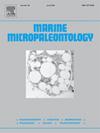利用有孔虫转移函数重建相对海平面
IF 1.5
4区 地球科学
Q2 PALEONTOLOGY
引用次数: 0
摘要
利用底栖有孔虫的转移函数被广泛用于重建古环境的变化,如海平面的相对变化和构造引起的沿岸垂直运动。这种重建是以具有代表性的现代训练数据集为基础的,通常是沿着要重建的环境梯度取样。训练数据集中的物种-环境关系可以通过适当的数值技术进行建模,然后将得到的传递函数模型应用到化石数据集中,重建古环境条件,如相对海平面的变化。虽然转移函数模型的建立和应用相对容易,但一些研究表明,这种方法也存在一些困难。本研究介绍并讨论了使用传递函数方法进行相对海平面估算时应考虑的各个方面。它集中讨论了现代物种与环境的关系,特别关注海洋环境,介绍了广泛使用的数值方法来开发传递函数,讨论了几种验证方法,并探讨了应用问题。本文章由计算机程序翻译,如有差异,请以英文原文为准。
Relative sea-level reconstructions by using foraminiferal transfer functions
Transfer functions, that use benthic foraminifera, are widely applied for reconstructions of changes in paleoenvironments such as relative sea-level changes and tectonic-induced vertical coastal motions. Such reconstructions are based on a representative modern training data sets, often sampled along the environmental gradient to be reconstructed. The species-environment relationships in a training data set can be modeled by using an adequate numerical technique, and the resulting transfer function model can then be applied to a fossil data set to reconstruct paleo-environmental conditions such as relative sea-level changes. Although transfer functions models are relatively easy to develop and to apply, several studies have shown that there are also difficulties with this approach. This study describes and discusses various aspects that should be considered when using the transfer function approach for relative sea-level estimates. It concentrates on the modern species-environment relations with a special focus on marine environments, describes widely used numerical methods for transfer function development, discusses several validation methods and addresses applications.
求助全文
通过发布文献求助,成功后即可免费获取论文全文。
去求助
来源期刊

Marine Micropaleontology
地学-古生物学
CiteScore
3.70
自引率
15.80%
发文量
62
审稿时长
26.7 weeks
期刊介绍:
Marine Micropaleontology is an international journal publishing original, innovative and significant scientific papers in all fields related to marine microfossils, including ecology and paleoecology, biology and paleobiology, paleoceanography and paleoclimatology, environmental monitoring, taphonomy, evolution and molecular phylogeny. The journal strongly encourages the publication of articles in which marine microfossils and/or their chemical composition are used to solve fundamental geological, environmental and biological problems. However, it does not publish purely stratigraphic or taxonomic papers. In Marine Micropaleontology, a special section is dedicated to short papers on new methods and protocols using marine microfossils. We solicit special issues on hot topics in marine micropaleontology and review articles on timely subjects.
 求助内容:
求助内容: 应助结果提醒方式:
应助结果提醒方式:


